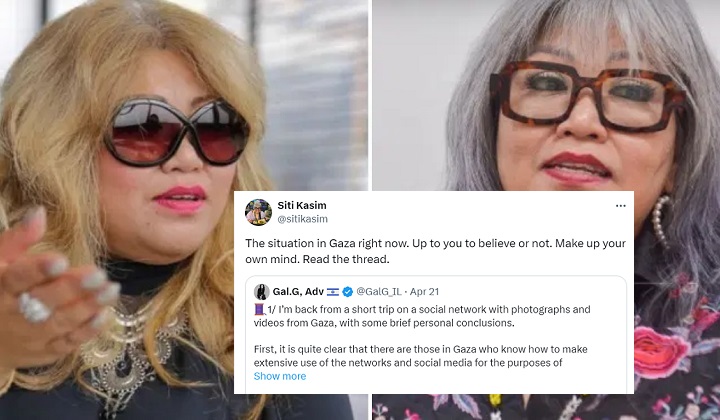Wanna Celebrate A Malaysian Deepavali? Here’s How To Do It In Style
From setting rows of oil clay lamps to getting oil baths, here are some of the things Malaysian Hindus do to prepare for Deepavali.

Subscribe to our Telegram channel for the latest stories and updates.
In case you’re wondering, not all Indian Malaysians are Hindu Tamil. Hence, not every Indian celebrates Deepavali. We have Malayalees, Telugus, Punjabis, Bengalis, Sindhis and Gujaratis, who are not all Hindus. They may practice Islam, Christianity, Sikhism, Buddhism, Jainism and even the Baháʼí Faith.
READ MORE: Attention Malaysia, Deepavali Isn’t An Indian Stereotype
However, since Deepavali is one of the biggest religious and cultural celebrations in Malaysia, let’s talk about how some Indian Malaysians celebrate it.
We asked a few Malaysian Hindus questions on how they prepare for Deepavali in Malaysia and here are their answers.
READ MORE: 7 Things ALL Malaysians Love About Deepavali
The meaning and story behind Deepavali
In Sanskrit, Deepavali or Diwali means ‘Row of Lights’ – it usually falls in late October or early November, according to the Indian lunar calendar. It marks a time to come together and rejoice in the triumph of good over evil, glorifying light over darkness.
Renu, a banker by day and Odissi dancer by night, knows two stories that relate to Deepavali, one is the tale of Lord Rama over Ravana and another one is the tale of Lord Krishna over Narakasura.
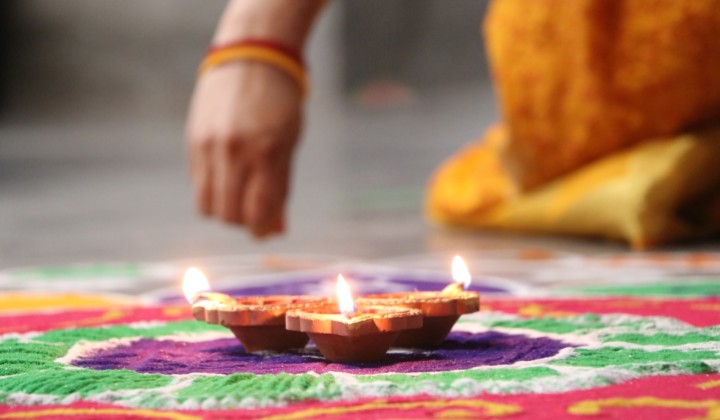
The tale of Ramayana tells a story of how Lord Rama (hero and son of royalty) went to fight off Ravana (demon king with many heads) that kidnapped his wife, Sita with the help of his brother Laksamana.
Their triumphant journey back to Ayodhya after 14 years of exile (caused by his evil stepmother) and after defeating Ravana was celebrated with joy and with rows of lights on the streets. So in this story, Deepavali is associated with the return of Lord Rama to his kingdom.

Another tale tells the story of how Lord Krishna defeats Narakasura (demon king covered in filth). Narakasura kidnapped over 16,000 women in his palace and meted out harsh punishments to his subjects that defy him.
Lord Krishna killed the demon and rescued the women from his captivity. Deepavali here honours the victory of Lord Krishna and marks the meaning of freedom.
The Decorations
Before a house is ready to accept guests, it must be thoroughly cleaned and filled with some decorations to show the festive spirits. For Shan, a fresh graduate from Universiti Sains Malaysia, the common decorations that his family uses are Kolam, Diyas, and flower garlands.
Kolam / Rangoli
Kolam is traditional decorative art, usually made by using coloured rice grains or rice flour. It is displayed at the entrance of a house or premises, usually at the door.
According to Shan, the outlines of a Kolam are drawn first using white chalk or flour. Then, once the outlines are drawn completely, the coloured rice grains or rice flour will be filled in the designs/outlines, bringing the beauty of Kolam to life.
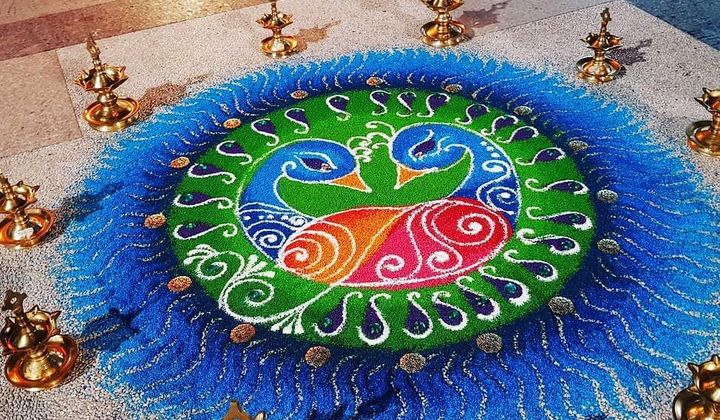
(Credit: S4SKY Rangoli Kolam Malaysia)
Originally made to feed small insects like ants, Kolam was not meant for decoration and was mostly made with white flour. Over time, it has evolved into a more colourful, decorative piece of art, especially for festivities like Deepavali, Ponggal and weddings.
There are different types of Kolams such as the Rangoli, Chariot Kolams, Symmetrical Kolams, and the most popular one, Kolam with Peacock designs, as you can see from the above picture.
Find out more about Kolams in the article below.
READ MORE: What Are Those Pretty Colourful Designs On The Floor During Deepavali?
Oil lamps – Diyas 🪔
Next, of course, we need lights, come on, it’s Deepavali, the ‘festival of lights’.
Shan
Okay, another common decoration that we use during Deepavali is oil-clay lamps or known as Diyas.
Being small pots made from clay, they are also called ‘thumb pots’ as they are made by pressing the thumb into a ball of clay and shaping it. Nowadays, Diyas are also hand-painted with designs, and these oil lamps are a great decoration alongside the Kolam.
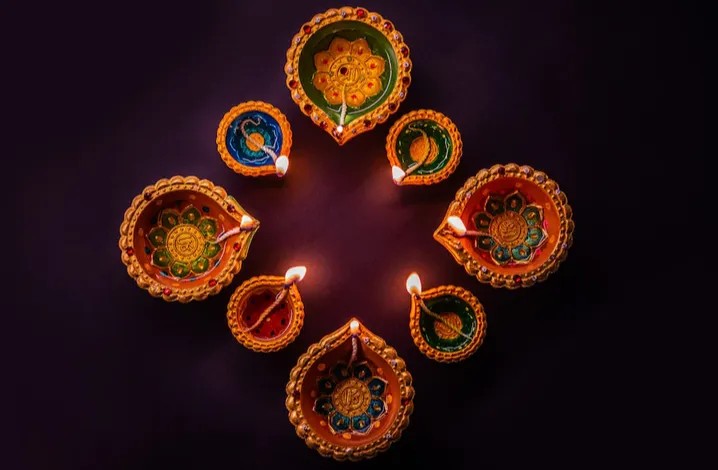
Diyas symbolise goodness and purity, and lighting them up is sort of like dispelling darkness and going into the light. It represents enlightenment, prosperity, knowledge and wisdom.
According to Shan, these oil-clay lamps are filled with ghee or oil before lighting them up. They are often placed inside the house, near the prayer altar, and also at the entrance of a house, creating an illuminating pathway of lights.
It is also believed that the trail of diyas would guide Lakshmi, the Goddess of wealth into homes so that its occupants could receive blessings of prosperity.
Flower Garlands
Following Diyas, we also decorate our houses with flower garlands, at the entrance, prayer altar, halls and more.
Shan
These flower garlands are available in two variations, synthetic and fresh flowers. Even though fresh flowers are preferred, synthetic flower garlands are gaining popularity nowadays. That’s because they are easier to maintain and can be found in stores easily.

(Credit: Hari Anggara / Malaymail)
Because of their bright colours, flowers such as Marigolds (commonly yellow or orange) are usually preferred for Deepavali festivities. In Hinduism, these orange and yellow flowers are considered auspicious, especially for new beginnings and important life events.
During Deepavali, both Ganesh and Lakshmi are worshipped and to honour the gods, many people decorate their homes with marigold flowers or garlands.
Other modern decorations
For modern decorations. We have pre-made Kolams that are made with synthetic coloured beads, so you just purchase them and can be displayed straight away.
Shan
We also have decorations that incorporate our religious deities such as Lord Ganesha, Goddess Durga and Goddess Lakshmi.
These decorative pieces are also installed together with colourful lights, and some of them are even waterproof and battery-powered, how cool is that.
The Usual Practice
The usual routine during Deepavali besides getting the decorations ready is the symbolic oil bath.
The normal practice on Deepavali morning is the oil bath. Basically, the elders in the house will put sesame oil on our heads and we will take a bath with it.
Renu
Some people will massage the whole body but some of us don’t really have time for a full massage that morning honestly. We just put the oil on our heads, rub it a bit and then we bathe. It’s a belief to cleanse ourselves with oil on Deepavali day.

And some practice going to the temple to pray. The whole family going temple is also a good ritual on Deepavali morning. However, some people even do their open houses in the morning, hence sometimes, we really can’t make it in time to the temple.
Renu
Renu also added that after the morning, the celebration goes as a regular Malaysian festive day goes.
There’s the wearing of traditional clothes, the scrumptious buffet with all the sweets, getting monetary gifts (ang pau/duit raya, hello!) from elders, rejoicing with beloved families as well as friends, and fireworks (everyone looks forward to this one)!
READ MORE: 11 Must-Try Indian Desserts To Sweeten Up Your Deepavali Weekend
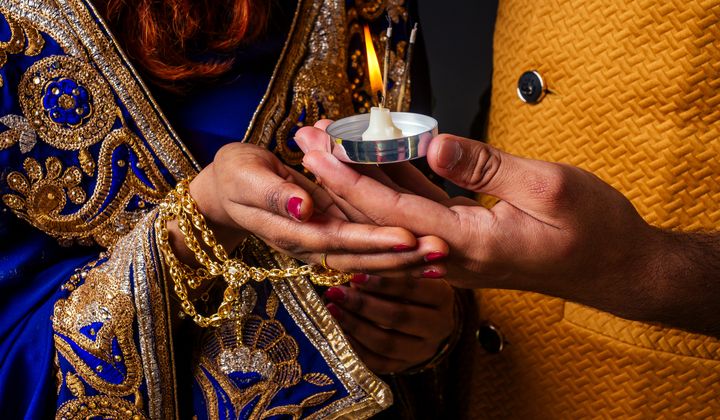
Thanks to Renu and Shan, we now have a clearer picture of how some Malaysian Hindus celebrate Deepavali. We just look forward to getting open house invitations and hogging all the food. 🤭
Deepavali is not the only big celebration for Indian Malaysians. They have other celebrations too and they mostly coincide in April. Read the article below to find out more about Vishu, Vaisakhi and Chittirai Puttandu.
READ MORE: Did You Know April Is A Pretty Big Deal For Malaysian Indians?
Share your thoughts with us via TRP’s Facebook, Twitter, and Instagram.




